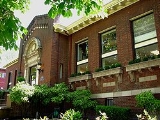
East Portland Branch, Public Library of Multnomah County
Encyclopedia
The East Portland Branch, Public Library of Multnomah County housed part of the library system
of Multnomah County, Oregon
, from 1911 to 1967. Designed by architect A. E. Doyle
, the structure was completed in 1911 in Portland
at 1110 Southeast Alder Street in the city's central eastside. Funded in part by the Carnegie Foundation
, the original building consisted of one floor and a daylight basement and included reading rooms for children and adults. The building had a red brick exterior, terra-cotta
trim, and a roof of green Spanish tiles. Remodeled in 1956 and remodeled again prior to its sale in 1967, the one-story building, which had rooms 18 feet (5.5 m) high, became a two-story office building.
From 1864 until 1902, Portland had subscription
libraries that were open to the public, but it had no tax-supported public library. In 1902, the library system became tax-supported, free, and open to all Portland residents. A year later, it was opened to all residents of Multnomah County
. Within months of the change from subscription library to free public library, the number of users grew from 1,000 members to 8,000 registered borrowers.
The subscription libraries had reading rooms only in downtown Portland
. To accommodate the growing number of users, the new library established reading rooms in other parts of the city. By 1907, it had neighborhood branches in Sellwood
, Albina
and the central eastside neighborhood. Doyle designed a small temporary building for the eastside branch before money became available for the permanent structure.
Multnomah County Library
Multnomah County Library is a public library system serving Multnomah County, Oregon, United States. Started in 1864, the system has 19 library locations with books, magazines, DVDs, and computers. It is the largest library system in Oregon serving a population of 724,680, with more than 425,000...
of Multnomah County, Oregon
Multnomah County, Oregon
Multnomah County is one of 36 counties in the U.S. state of Oregon. Though smallest in area, it is the most populous as its county seat, Portland, is the state's largest city...
, from 1911 to 1967. Designed by architect A. E. Doyle
A. E. Doyle
Albert Ernest Doyle was a prolific architect in the U.S. states of Oregon and Washington. He is most often credited for his works as A.E. Doyle....
, the structure was completed in 1911 in Portland
Portland, Oregon
Portland is a city located in the Pacific Northwest, near the confluence of the Willamette and Columbia rivers in the U.S. state of Oregon. As of the 2010 Census, it had a population of 583,776, making it the 29th most populous city in the United States...
at 1110 Southeast Alder Street in the city's central eastside. Funded in part by the Carnegie Foundation
Carnegie Corporation of New York
Carnegie Corporation of New York, which was established by Andrew Carnegie in 1911 "to promote the advancement and diffusion of knowledge and understanding," is one of the oldest, largest and most influential of American foundations...
, the original building consisted of one floor and a daylight basement and included reading rooms for children and adults. The building had a red brick exterior, terra-cotta
Glazed architectural terra-cotta
Glazed architectural terra-cotta is a ceramic masonry building material popular in the United States from the late 19th century until the 1930s, and still one of the most common building materials found in U.S. urban environments...
trim, and a roof of green Spanish tiles. Remodeled in 1956 and remodeled again prior to its sale in 1967, the one-story building, which had rooms 18 feet (5.5 m) high, became a two-story office building.
From 1864 until 1902, Portland had subscription
Subscription library
A subscription library is a library that is financed by private funds either from membership fees or endowments...
libraries that were open to the public, but it had no tax-supported public library. In 1902, the library system became tax-supported, free, and open to all Portland residents. A year later, it was opened to all residents of Multnomah County
Multnomah County, Oregon
Multnomah County is one of 36 counties in the U.S. state of Oregon. Though smallest in area, it is the most populous as its county seat, Portland, is the state's largest city...
. Within months of the change from subscription library to free public library, the number of users grew from 1,000 members to 8,000 registered borrowers.
The subscription libraries had reading rooms only in downtown Portland
Central Library (Portland, Oregon)
The Central Library is a three-story public library branch in downtown Portland, Oregon, United States. Opened in 1913, it serves as the main branch of the Multnomah County Library system...
. To accommodate the growing number of users, the new library established reading rooms in other parts of the city. By 1907, it had neighborhood branches in Sellwood
Sellwood, Portland, Oregon
Sellwood-Moreland is a neighborhood on a bluff overlooking the Willamette River in Southeast Portland, Oregon, bordering Westmoreland to the north, Eastmoreland to the east, and the city of Milwaukie to the south...
, Albina
Albina, Oregon
Albina is a historical city which was consolidated into Portland, Oregon in 1891.Albina was laid out in 1872 with a plat for the new town filed in April 1873 by Edwin Russell, William Page, and George Williams. Albina was named after Mrs. Albina Page, the wife of William Page. Settlement began in...
and the central eastside neighborhood. Doyle designed a small temporary building for the eastside branch before money became available for the permanent structure.

